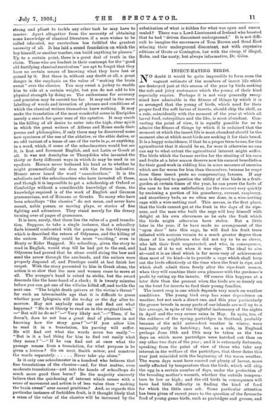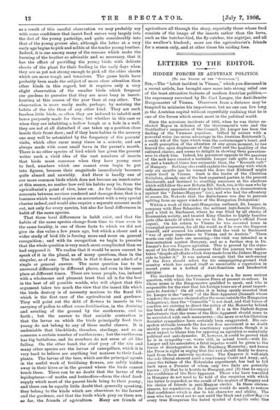INSECT-EATING BIRDS.
NO -doubt it would be quite impossible to form even the vaguest estimate of the numbers of insect life which are destroyed just at this season of the year by birds seeking the soft and juicy sustenance which the young of their kind especially require. Perhaps it is not very generally recog- nised how admirable is the fitness of things by which it is so arranged that the young of birds, which need for their proper food the soft larvae of insects, should chip the shell, as a rule, coincidently with the moment of the year at which all larval food, caterpillars and the like, is most abundant. Con- verting the point of view, it is equally possible for us to admire the fitness of things by which it is ordained that the moment at which the insect life is most abundant should be the moment also at which most birds are seeking it for their brood. It is a happy coincidence, if that be a proper term to use, for the agriculturist that it should be so, for were it otherwise no one can say to what extent the agricultural interest might suffer. The birds which the farmer reviles for the stealing of his corn and fruits at a later season deserve now his earnest benediction for their good work in ridding him in some measure of enemies which are far worse for him than themselves, because he reaps from these insect pests no compensating favours. If any man is disposed to question the utility of the birds in a fruit- garden at certain times of the year, he can prove the facts of the case to his own satisfaction (or the reverse) very quickly by enclosing a portion of his gooseberry, currant, raspberry, and strawberry beds, as we often see done, in a wire-netting cage with a wire-netting roof. This means, in the first place, that the birds cannot get at the fruit in the days of its ripe- ness, and the man who built the cage will hug himself with delight at his own cleverness as he eats the fruit which the birds might otherwise have stolen. But a little later in the year, if he have made no arrangement of the "open door" into this cage, be will find- his fruit trees infested with noxious vermin to a much greater degree than those of his neighbours who did not try to be so clever, who left their fruit unprotected, and who, in consequence, had less of it to eat when it was ripe. The ideal to aim at—and it is an ideal which is far more easy of achievement than most of its kind—is to provide a cage which shall keep out the birds effectively at the time when the fruit is ripe, and which shall admit them freely after the ripe-fruit season, when they will combine their own pleasure with the gardener's profit by eating up the insects. Of course this happens at a later date than the present when the birds are so keenly set on the hunt for insects to feed their young families.
The insect crop is one which depends very much on weather conditions. The young bird crop has some dependence on weather, but not such a direct one, and this year particularly the grouse broods in many parts of our islands are well up to a fair average, in spite of the frightful inclemency of the nights in April and the very severe rains in May. In spite, too, of the coldness of the spring, partridges in Scotland, probably because of the mild antecedent weather in winter, were unusually early in hatching ; but, as a rule, in England perhaps June 18th and 19th may be taken as the two days on which more partridges were hatched out than on any other two days of the year ; and it is extremely fortunate, speaking from the point of view of those who take any interest in the welfare of the partridges, that these dates this year just coincided with the beginning Of the warm weather. The warm days must have coaxed out plenty of larvae, more easily affected by temperature than the birds, which will chip the egg in a certain number of days, Under the protection of the brooding mother's warmth, whether the 'outside tempera- ture be low or high ; and the old birds in consequence will have had little difficulty in finding the kind of food for which the little ones ask. Some particular attention has been given of recent years to the question of the favourite food of young game birds, such as partridges and grouse, and as a result of this careful observation we may probably say with some confidence that insect food enters very largely into the diet of the young partridge, and quite considerably into that of the young grouse also, although the latter at a very early age begins to pick and nibble at the tender young heather. Indeed, it is one among many of the reasons which make the burning of the heather so advisable and so necessary, that it has the effect of providing the young birds with delicate shoots of the plant for their feeding in the early days when they are as yet not strong enough to pick off the older shoots which are more tough and tenacious. The game birds have probably been made the subject of more close attention than other kinds in this regard, but it requires only a very slight observation of the smaller birds which frequent our gardens to perceive that they are more busy in insect- hunting at this season of the year than at any other. The observation is more easily made, perhaps, by noticing the habits of the tits than of any other kind. They are such fearless little birds, so often they are induced to inhabit nest boxes purposely made for them ; but whether in this case or when they are inhabiting a hollow bough or a bole in a wall, they are not at all disturbed if one takes up a position close beside their front door; and if they have babies in the nursery one may well be astonished by the frequency of the parents' visits, which ofter recur many times in a minute, and are always made with some small larva in the parent's mouth. There is no other species of bird which has given the present writer such a vivid idea of the vast numbers of insects that birds must consume when they have young ones to feed, numbers which one cannot even begin to put into figures, because their magnitude immediately becomes quite absurd and unwieldy. And there is hardly one of our more common birds which does not become an insect-eater at this season, no matter how evil his habits may be, from the agriculturist's point of view, later on. As for balancing the accounts between services rendered and damage done, that is a business which would require an accountant with a very special charter indeed, and would also require a separate account made out, not only for every species, but also for local differences in habit of the same species.
That these local differences in habit exist, and that the habits of the same species change from time to time even in the same locality, is one of those facts to which we did not give its due value a few years ago, but which a closer and a wider study of bird life is forcing more and more on general recognition ; and with its recognition we begin to perceive that the whole question is very much more complicated than we had supposed it. We realise that it would be more correct to speak of it in the plural, as of many questions, than in the singular, as of one. The truth is that it does not admit of a single or general answer. The same question has to be answered differently in different places, and even in the same place at different times. There are some people, too, imbued with a wholesome and pleasant trust that all is for the best in the beat of all possible worlds, who will object that this argument takes too much the view that the insect life which the birds destroy is of necessity noxious to the floral life which is the first care of the agriculturist and gardener. They will point out the debt of flowers to insects in the carrying of pollen to effect cross-fertilisation, in the draining and aerating of the ground by the earthworm, and so forth ; but the answer to that amiable contention is that the larvae on which the birds principally feed their young do not belong to any of these useful classes. It is undeniable that blackbirds, thrushes, starlings, and so on consume a certain number of earthworms ; but the earthworm has big battalions, and its numbers do not seem at all like failing. On the other hand, the chief prey of the tits and many other species are the larvae of caterpillars, which it is very hard to believe are anything but noxious to their food- plants. The larvae of the bees, which are the principal agents in the useful work of fertilising flowers, are safely hidden away in their hives or in the ground where the birds cannot touch, them. There can be no doubt that the larvae of the lepidopterae—of moths and butterflies—form the chief food- supply which most of the parent birds bring to their young ; and there can be equally little doubt that, generally speaking, they belong to the kinds which are obnoxious to the farmer and the gardener, and that the birds which prey on them are, so far, the friends of agriculture. Many are friends of agriculture all through the story, especially those whose food consists of the imago of the insects rather than the larva, such as the butcher-bird, the fly-catcher, the nightjar, and all the swallow's kindred ; more are the agriculturist's friends for a season only, and at other times his raiding foes.



















































 Previous page
Previous page